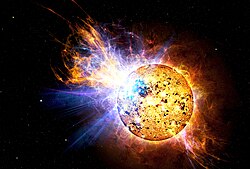Wikipedia:Featured picture candidates/Pipsqueak Star Unleashes Monster Flare
Appearance

- Reason
- A good picture
- Articles this image appears in
- EV Lacertae
- Creator
- Created by NASA
- Support as nominator --Jorghe'-X(Sorry for my bad Englis is beacause I'm Mexican) 04:40, 27 June 2008 (UTC)
- Oppose - this is only an artist's conception. I've voted against such before... --Janke | Talk 19:37, 27 June 2008 (UTC)
- Is there a rule against those? Fletcher (talk) 01:42, 28 June 2008 (UTC)
- No, of course not. But neither is there a rule forbidding me to oppose... ;-) Seriously, I think an artist's conception of a scientific subject is seldom enc enough to be FP. --Janke | Talk 07:47, 28 June 2008 (UTC)
- Is there a rule against those? Fletcher (talk) 01:42, 28 June 2008 (UTC)
- Oppose - very pretty but no real encyclopaedic value for the article it appears in. Does draw the reader in but provides no useful information - Peripitus (Talk) 00:55, 28 June 2008 (UTC)
- Comment I don't think I have the experience to comment on FPC (er, other than the image I'm already commenting on), but definitely I can say the caption needs rewriting for grammar and brevity. The image does seem encyclopedic to me -- provided someone who knows astronomy can confirm it looks technically accurate -- but it's linked to a stub article, which is tagged for references. I think it would be kind of embarrassing to link to that from the main page. Fletcher (talk) 01:42, 28 June 2008 (UTC)
- Oppose It's an artwork with a terrible caption Capital photographer (talk) 11:01, 28 June 2008 (UTC)
- Oppose Speaking as an amateur astronomer, I can tell you that this is not very scientifically accurate. Nor is the technical quality very good, especially considering that it is an artist's rendering. The lack in accuracy would be forgivable if this were a particularly good artist's rendering, but that is simply not the case. Compare the image to this or this for example. It's tough to support astronomical artist's renderings, all of them have wow, but how do you differ them from typical space art? TheOtherSiguy (talk) 23:01, 30 June 2008 (UTC)
- Oppose per previous opposers. Papa Lima Whiskey (talk) 17:38, 2 July 2008 (UTC)
Not promoted . --John254 04:53, 3 July 2008 (UTC)
